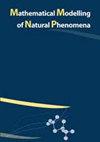耦合传染性和非传染性疾病的最小模型
IF 2.1
4区 数学
Q2 MATHEMATICAL & COMPUTATIONAL BIOLOGY
引用次数: 0
摘要
这项工作提出了一个结合最简单的传染病和非传染性疾病模型的模型。到目前为止,后者是世界上疾病和死亡的主要原因,并在传染病发生的人群中造成了基本的异质性。该模型可以解释为风险结构模型,这是另一种解释人口异质性的方法。我们的研究结果表明,考虑到非传染性疾病(最终,异质性人群),即使基本繁殖数小于1美元,传染病也会成为地方病。这个特征被称为亚临界分岔。此外,忽视非传染性疾病的动态会导致对繁殖数量的高估,从而对实际感染人数给出错误的信息。我们计算了敏感性指数,得到了有趣的流行病控制信息。本文章由计算机程序翻译,如有差异,请以英文原文为准。
A minimal model coupling communicable and non-communicable diseases
This work presents a model combining the simplest communicable and non-communicable disease models. The latter is, by far, the leadingn cause of sickness and death in the World, and introduces basal heterogeneity in populations where communicable diseases evolve. The model can be interpreted as a risk-structured model, another way of accounting for population heterogeneity.
Our results show that considering the non-communicable disease (in the end, heterogeneous populations) allows the communicable disease to become endemic even if the basic reproduction number is less than $1$. This feature is known as subcritical bifurcation. Furthermore, ignoring the non-communicable disease dynamics results in overestimating the reproduction number and, thus, giving wrong information about the actual number of infected individuals. We calculate sensitivity indices and derive interesting epidemic-control information.
求助全文
通过发布文献求助,成功后即可免费获取论文全文。
去求助
来源期刊

Mathematical Modelling of Natural Phenomena
MATHEMATICAL & COMPUTATIONAL BIOLOGY-MATHEMATICS, INTERDISCIPLINARY APPLICATIONS
CiteScore
5.20
自引率
0.00%
发文量
46
审稿时长
6-12 weeks
期刊介绍:
The Mathematical Modelling of Natural Phenomena (MMNP) is an international research journal, which publishes top-level original and review papers, short communications and proceedings on mathematical modelling in biology, medicine, chemistry, physics, and other areas. The scope of the journal is devoted to mathematical modelling with sufficiently advanced model, and the works studying mainly the existence and stability of stationary points of ODE systems are not considered. The scope of the journal also includes applied mathematics and mathematical analysis in the context of its applications to the real world problems. The journal is essentially functioning on the basis of topical issues representing active areas of research. Each topical issue has its own editorial board. The authors are invited to submit papers to the announced issues or to suggest new issues.
Journal publishes research articles and reviews within the whole field of mathematical modelling, and it will continue to provide information on the latest trends and developments in this ever-expanding subject.
 求助内容:
求助内容: 应助结果提醒方式:
应助结果提醒方式:


